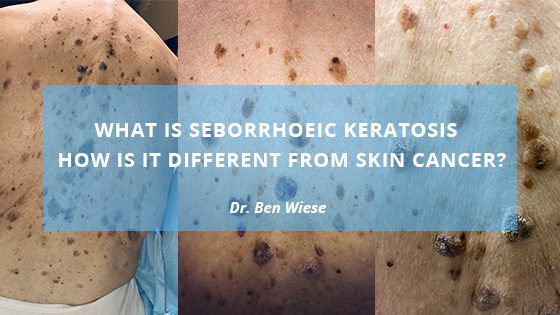It’s normal for people to watch their skin closely and worry that new spots or growths may be signs of skin cancer. However, many common skin growths are harmless. In fact, only a small percentage of new cancer cases in North America are melanoma, and seborrhoeic keratosis is one of the conditions we see most often in clinic settings. This article explains what seborrhoeic keratosis is and how it differs from skin cancer.
What Is Seborrhoeic Keratosis?
Seborrhoeic keratoses (sometimes called seborrhoeic warts) are benign growths that form due to a build-up of skin cells. They are common, non-cancerous and often appear as people age.
A seborrhoeic keratosis can look:
- brown, black or tan
- slightly raised
- waxy or “pasted on”
- rough or scaly
They may appear on the face, chest, back or shoulders. Some people develop only one, while others may have several.
Seborrhoeic Keratosis vs. Skin Cancer
Seborrhoeic keratoses do not turn into cancer and are not considered pre-cancerous.
A trained healthcare provider can often distinguish seborrhoeic keratosis from skin cancer through a visual examination. Typical SK growths tend to be:
- flat or slightly raised
- waxy in appearance
- generally unchanged over time
Skin cancers, on the other hand, may change in size, shape or colour. If you notice a growth that resembles seborrhoeic keratosis but begins to change, become irritated or grow, speak with your doctor.
What Causes Seborrhoeic Keratosis?
The exact cause is not fully known, but several factors may contribute:
- sun exposure
- genetics or family tendency
Seborrhoeic keratoses are not contagious and do not spread from person to person.
Symptoms and General Characteristics
Seborrhoeic keratoses are usually painless and do not require treatment. Common features include:
- rough or waxy surface
- colour ranging from golden brown to almost black
- gradual thickening or enlargement over time
- size ranging from under one centimetre to several centimetres
- tendency to remain once developed, with new ones appearing over the years
Avoid rubbing, scratching or picking at these growths, as this can lead to irritation, bleeding or, in rare cases, infection.
Treatment Options
Most seborrhoeic keratoses do not need treatment. Some people choose removal if the growth becomes bothersome or if they dislike its appearance.
Removal methods may include:
- freezing the growth with liquid nitrogen
- cutting or shaving the growth under local anaesthetic

Topical options sometimes used for bothersome SKs include:
- urea 25% cream, applied 2–3 times per day
- salicylic acid 8%, applied morning and evening
A healthcare provider can suggest the most appropriate approach depending on the growth and its location.
When to See a Doctor
Seborrhoeic keratoses can appear at any age but are most common in older adults. Always contact your doctor if you notice a new or existing spot that:
- changes in appearance
- becomes irritated or inflamed
- looks unusual or concerning to you
A medical evaluation can help determine whether the spot is benign or requires further assessment.




